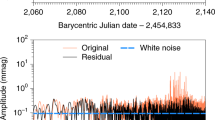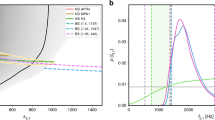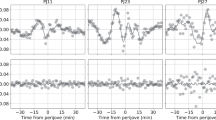Abstract
Red giants are evolved stars that have exhausted the supply of hydrogen in their cores and instead burn hydrogen in a surrounding shell1,2. Once a red giant is sufficiently evolved, the helium in the core also undergoes fusion3. Outstanding issues in our understanding of red giants include uncertainties in the amount of mass lost at the surface before helium ignition and the amount of internal mixing from rotation and other processes4. Progress is hampered by our inability to distinguish between red giants burning helium in the core and those still only burning hydrogen in a shell. Asteroseismology offers a way forward, being a powerful tool for probing the internal structures of stars using their natural oscillation frequencies5. Here we report observations of gravity-mode period spacings in red giants6 that permit a distinction between evolutionary stages to be made. We use high-precision photometry obtained by the Kepler spacecraft over more than a year to measure oscillations in several hundred red giants. We find many stars whose dipole modes show sequences with approximately regular period spacings. These stars fall into two clear groups, allowing us to distinguish unambiguously between hydrogen-shell-burning stars (period spacing mostly ∼50 seconds) and those that are also burning helium (period spacing ∼100 to 300 seconds).
This is a preview of subscription content, access via your institution
Access options
Subscribe to this journal
Receive 51 print issues and online access
$199.00 per year
only $3.90 per issue
Buy this article
- Purchase on Springer Link
- Instant access to full article PDF
Prices may be subject to local taxes which are calculated during checkout



Similar content being viewed by others
References
Schwarzschild, M. & Härm, R. Red giants of population II. II. Astrophys. J. 136, 158–165 (1962)
Iben, I., Jr Low-mass red giants. Astrophys. J. 154, 581–595 (1968)
Sweigart, A. V. & Gross, P. G. Evolutionary sequences for red giant stars. Astrophys. J. Suppl. Ser. 36, 405–437 (1978)
Charbonnel, C. in Cosmic Abundances as Records of Stellar Evolution and Nucleosynthesis (eds Barnes, T. G. & Bash, F. N. ) 119–130 (Vol. 336, Astronomical Society of the Pacific Conference Series, 2005)
Aerts, C., Christensen-Dalsgaard, J. & Kurtz, D. W. Asteroseismology (Springer, 2010)
Beck, P. G. et al. Detection of gravity-mode period spacings in red giant stars by the Kepler Mission. Science (in the press)
De Ridder, J. et al. Non-radial oscillation modes with long lifetimes in giant stars. Nature 459, 398–400 (2009)
Kallinger, T. et al. Oscillating red giants in the CoRoT exo-field: asteroseismic radius and mass determination. Astron. Astrophys. 509, A77 (2010)
Bedding, T. R. et al. Solar-like oscillations in low-luminosity red giants: first results from Kepler. Astrophys. J. 713, L176–L181 (2010)
Huber, D. et al. Asteroseismology of red giants from the first four months of Kepler data: global oscillation parameters for 800 stars. Astrophys. J. 723, 1607–1617 (2010)
Mosser, B. et al. The universal red-giant oscillation pattern. An automated determination with CoRoT data. Astron. Astrophys. 525, L9 (2011)
Dziembowski, W. A., Gough, D. O., Houdek, G. & Sienkiewicz, R. Oscillations of α UMa and other red giants. Mon. Not. R. Astron. Soc. 328, 601–610 (2001)
Christensen-Dalsgaard, J. Physics of solar-like oscillations. Sol. Phys. 220, 137–168 (2004)
Dupret, M. et al. Theoretical amplitudes and lifetimes of non-radial solar-like oscillations in red giants. Astron. Astrophys. 506, 57–67 (2009)
Montalbán, J., Miglio, A., Noels, A., Scuflaire, R. & Ventura, P. Seismic diagnostics of red giants: first comparison with stellar models. Astrophys. J. 721, L182–L188 (2010)
Di Mauro, M. P. et al. Solar-like oscillations from the depths of the red-giant star KIC 4351319 observed with Kepler. Mon. Not. R. Astron. Soc. (submitted)
Tassoul, M. Asymptotic approximations for stellar nonradial pulsations. Astrophys. J. Suppl. Ser. 43, 469–490 (1980)
Miglio, A., Montalbán, J., Eggenberger, P. & Noels, A. Gravity modes and mixed modes as probes of stellar cores in main-sequence stars: from solar-like to β Cep stars. Astron. Nachr. 329, 529–534 (2008)
Aizenman, M., Smeyers, P. & Weigert, A. Avoided crossing of modes of non-radial stellar oscillations. Astron. Astrophys. 58, 41–46 (1977)
Deheuvels, S. & Michel, E. New insights on the interior of solar-like pulsators thanks to CoRoT: the case of HD 49385. Astrophys. Space Sci. 328, 259–263 (2010)
Jenkins, J. M. et al. Initial characteristics of Kepler long cadence data for detecting transiting planets. Astrophys. J. 713, L120–L125 (2010)
Mosser, B. & Appourchaux, T. On detecting the large separation in the autocorrelation of stellar oscillation times series. Astron. Astrophys. 508, 877–887 (2009)
Gough, D. O. in Hydrodynamic and Magnetodynamic Problems in the Sun and Stars (ed. Osaki, Y. ) 117–143 (Univ. Tokyo Press, 1986)
Girardi, L. A secondary clump of red giant stars: why and where. Mon. Not. R. Astron. Soc. 308, 818–832 (1999)
Miglio, A. et al. Probing populations of red giants in the galactic disk with CoRoT. Astron. Astrophys. 503, L21–L24 (2009)
Kjeldsen, H. & Bedding, T. R. Amplitudes of stellar oscillations: the implications for astero-seismology. Astron. Astrophys. 293, 87–106 (1995)
Christensen-Dalsgaard, J. ASTEC – the Aarhus STellar Evolution Code. Astrophys. Space Sci. 316, 13–24 (2008)
Kjeldsen, H., Bedding, T. R. & Christensen-Dalsgaard, J. Correcting stellar oscillation frequencies for near-surface effects. Astrophys. J. 683, L175–L178 (2008)
Ventura, P., D'Antona, F. & Mazzitelli, I. The ATON 3.1 stellar evolutionary code. A version for asteroseismology. Astrophys. Space Sci. 316, 93–98 (2008)
Pietrinferni, A., Cassisi, S., Salaris, M. & Castelli, F. A large stellar evolution database for population synthesis studies. I. Scaled solar models and isochrones. Astrophys. J. 612, 168–190 (2004)
Acknowledgements
We acknowledge the entire Kepler team, whose efforts made these results possible. We thank M. Biercuk for comments. Funding for this Discovery mission was provided by NASA's Science Mission Directorate. T.R.B and D.S. were supported by the Australian Research Council; P.B. and C.A. were supported by European Community's 7th Framework Programme (PROSPERITY); S.H. was supported by the Netherlands Organisation for Scientific Research (NWO). The National Center for Atmospheric Research is sponsored by the National Science Foundation.
Author information
Authors and Affiliations
Contributions
T.R.B, B.M., P.B., Y.P.E, R.A.G., S.H., C.A., A.-M.B. and F.C. measured and interpreted period spacings; B.M., D.H., R.A.G., S.H., T.K., W.J.C., C.B., D.L.B. and S.M. calculated power spectra and measured large frequency separations; J.M., J.C.-D., A.M., D.S., T.R.W., K.B., M.P.D.M., M.-A.D., M.-J.G., S.K., A.N., V.S.A. and P.V. calculated and interpreted theoretical models; J.D.R., S.H., S.F., Y.P.E., D.S., T.M.B., H.K., J.C.-D. and R.L.G contributed to the coordination of the project, including the acquisition and distribution of the data; and J.M.J. constructed the photometric time series from the original Kepler pixel data. All authors discussed the results and commented on the manuscript.
Corresponding author
Ethics declarations
Competing interests
The authors declare no competing financial interests.
Supplementary information
Supplementary Table
This file contains a Supplementary Table listing the Red Giants that are shown in Figure 3 of the main paper. (PDF 106 kb)
Rights and permissions
About this article
Cite this article
Bedding, T., Mosser, B., Huber, D. et al. Gravity modes as a way to distinguish between hydrogen- and helium-burning red giant stars. Nature 471, 608–611 (2011). https://doi.org/10.1038/nature09935
Received:
Accepted:
Published:
Issue Date:
DOI: https://doi.org/10.1038/nature09935
This article is cited by
-
A close-in giant planet escapes engulfment by its star
Nature (2023)
-
Evidence of structural discontinuities in the inner core of red-giant stars
Nature Communications (2022)
-
Fundamental parameters of barium and CH stars from asteroseismic analysis: HD 33409, HD 20084 and HD 66812
Journal of Astrophysics and Astronomy (2022)
-
Chronologically dating the early assembly of the Milky Way
Nature Astronomy (2021)
-
Chronos - take the pulse of our galactic neighbourhood
Experimental Astronomy (2021)
Comments
By submitting a comment you agree to abide by our Terms and Community Guidelines. If you find something abusive or that does not comply with our terms or guidelines please flag it as inappropriate.



